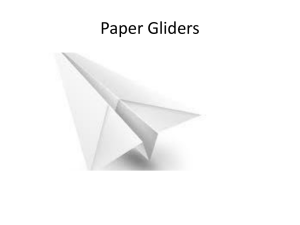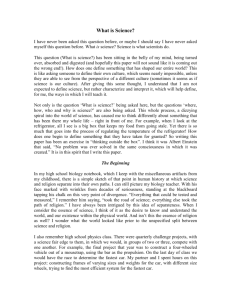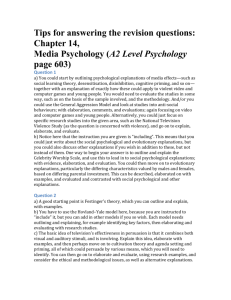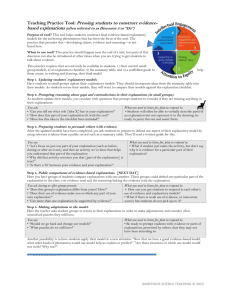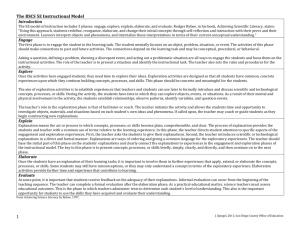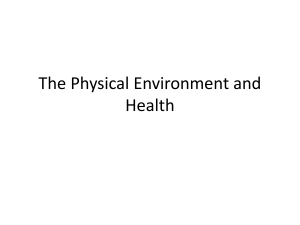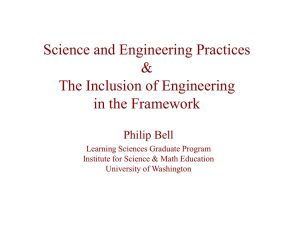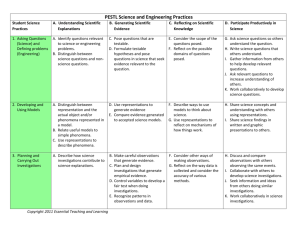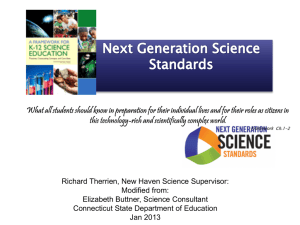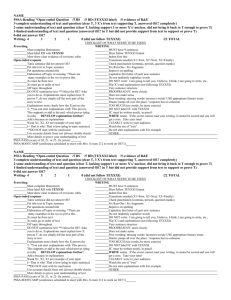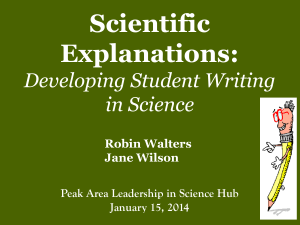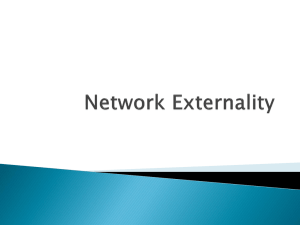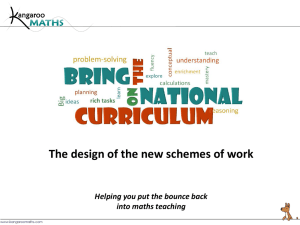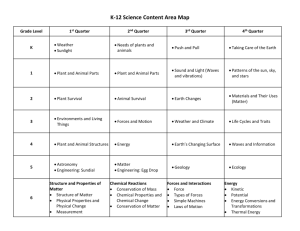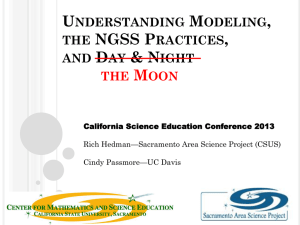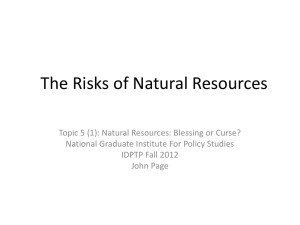Next Generation Science Standards
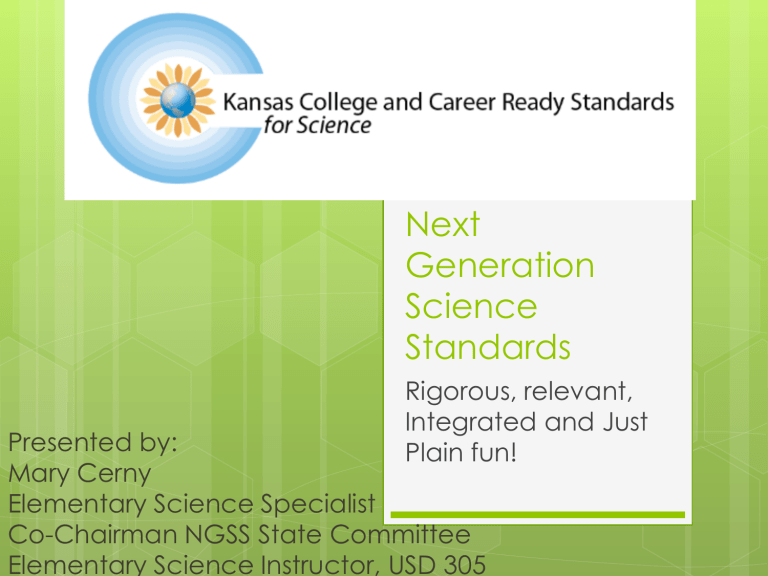
Next
Generation
Science
Standards
Presented by:
Mary Cerny
Rigorous, relevant,
Integrated and Just
Plain fun!
Elementary Science Specialist
Co-Chairman NGSS State Committee
Elementary Science Instructor, USD 305
Presentation Outcomes:
1. Become aware of your vision for science in your setting.
2. Figure out where you are personally in the process of implementation of the new science standards.
3. Build a stronger understanding of how the standards will look in your setting.
4. Gain more knowledge of what integration means.
Kansas State’s Vision
Who should be concerned about the standards?
A true science and technology dominated world creates informed citizens in a democracy.
Define Your Vision for Science in your setting.
1. What do you hope that your students learn about science?
2. Why is it important for students to learn about science in this way?
How does your vision effect other stakeholders in your community?
Other educators; pre-K through postsecondary
Other buildings in your district
Other KS districts
Parents
Business and industry
Museums, zoos, other informal educators
Stages of concern about new science standards:
Stage 0-Awareness
Not really interested
“Golly, I don’t know any of this.”
Stage 1-Information
Where can I get more information about this?
“I’ve got to learn and read more!”
How do I read the new standards?
Performance Expectations
Practices
Disciplinary Core Ideas
Crosscutting Concepts
Connections
Shift 1:
1. Real-world connected.
Shift 2:
8 Science and Engineering
Practices
1. Asking questions (for science) and defining problems (for engineering)
2. Developing and using models
3. Planning and carrying out investigations
4. Analyzing and interpreting data
5. Using mathematics and computational thinking
6. Constructing explanations (for science) and designing solutions (for engineering)
7. Engaging in argument from evidence
8. Obtaining, evaluating, and communicating information
Shift 3:
Disciplinary Core Ideas built coherently across K-12.
Shift 4:
Deeper understanding through application of content.
Shift 5:
Written for integration.
Shift 6:
Performance Expectations not curriculum.
Expect mastery at each grade level so new performance expectations can be mastered at next level.
Shift 7:
A solid K-12 Science Education prepares our students for college, careers and citizenship.
Complex World requires science knowledge to make sense of it all.
Back to your Vision
Why and how are the standards essential to your vision of success in your setting?
How do the standards support your vision of science education in Kansas?
Stage 2-Personal
This is going to be a lot of work!
“I’m scared to death and need to get out.”
Change is the law of life. And those who look only to the past
Or present are certain to miss the future.
John F. Kennedy
What do these standards look like in the classroom?
Every lesson will consist of three components which utilize science and engineering practices:
Gathering
Reasoning
Communicating
Gathering
• Obtain Information
• Ask Questions/Define Problems
• Plan & Carry Out Investigations
• Use Models to Gather Data
• Use Mathematics & Computational
Thinking
Reasoning
• Evaluate Information
• Analyze Data
• Use Mathematics and Computational
Thinking
• Construct Explanations/Solve Problems
• Developing Arguments from Evidence
• Use Models to Predict & Develop Evidence
Communicating
• Communicate Information
• Argue from Evidence (written & oral)
• Use Models to Communicate
What do these standards look like in the classroom?
Every lesson will use as many crosscutting concepts as useful for the type of task.
Causality
Systems
Patterns
Science and Engineering Practices
Performance: Explanations Using Evidence
Gather
Information
Re-design
Collaborate to Solve
Problems
Determine
Limitations
Test
Solutions
Design
Solutions
Similarities and Differences
Scientific Inquiry
Ask a question
Engineering Design
Define a problem
Obtain, evaluate, and communicate technical information
Plan investigations
Develop and use models
Obtain, evaluate, and communicate technical information
Plan designs and tests
Develop and use models
Design and conduct tests of experiments or models
Analyze and interpret data
Design and conduct tests of prototypes or models
Analyze and interpret data
Use mathematics and computational thinking
Construct explanations using evidence
Engage in argument using evidence
Use mathematics and computational thinking
Design solutions using evidence
Engage in argument using evidence
Adapted from A Framework for K-12 Science Education (NRC, 2011)
Performance: Developing Models to Support Explanations
Group Performance
Investigate how an airplane (glider) flies.
1. Individually Explore Solutions: Using a sheet of copy paper, design and build a paper airplane capable of flying a horizontal distance of 2X meters when you drop it from a height of X meters. You cannot throw the plane, only drop it.
2. In groups of three: Collaborate to solve the problem of flying a glider two times as far as the height from which it is dropped.
3. Formulate questions and investigate explanations for how the airplane flies.
4. Develop a model to show the forces on the airplane.
5. Develop evidence to support your explanations.
6. Write the steps of the engineering design process your group followed.
Individual Performance
7.
Write in your journal, or on note paper, your explanation that may be used to explain this phenomena to others. Include evidence to support your explanation for how the airplane is able to fly and develop a model to communicate your explanation.
Group Discussion
Reflection
8.
Reflect on the nature of science instruction that helps students to develop explanations based upon evidence and the role of the science and engineering practices for engaging students in gathering, reasoning, and communicating science ideas.
Performance: Developing Models to Support Explanations
Group Performance
Investigate how paper floats.
1. Individually Explore Solutions: Using a sheet of copy paper maximize the float time (time it takes to fall to the ground).
2. In Groups of Three: Collaborate to solve the problem of float time.
3. Formulate questions and investigate explanations for how the paper floats.
4. Develop a model to show the forces on the paper.
5. Develop evidence to support your explanations.
Individual Performance
6. Write in your journal, or on note paper, your explanation that may be used to explain this phenomena to others. Include evidence to support your explanation for how the paper floats slowly to the ground and develop a model to communicate your explanation.
Group Discussion
Reflection
7. Reflect on the Core ideas that help you make sense of how to maximize float time.
Stage 3-Management
I just don’t have the time to get this all done.
“This is awful.”
How soon are we supposed to be implemented?
How do we know when we have accomplished implementation?
Potential Measures of science
Performance:
Formatives
Graduation rate
STEM related careers/jobs
State exams tracking same students
???
How can we prepare our students to be successful on the unknown assessment?
Mastery of performance expectations
Mastery of engineering practices
Mastery of crosscutting concepts
Application of learned material
Stage 4-Consequence
I would like to excite my colleagues/students about their part in this program.
“How Can I help?”
How can we fit Science into the day?
Stage 5-Collaboration
We need to coordinate our delivery better, share ideas and
“team” it.
Stage 6-Refocusing
“I know everything there is to know.”
Resources:
Sign journal with your google email.
Standards document-Nextgenscience.org
KSDE-community.ksde.org
KSDE Science Apps page
KSDE Summer Academies
District Implementation Plan
Kansas Association of Teachers of Science-
KATS.org
National Science Teachers Association-
NSTA.org
Learning Forward-Learningforwardkansas.org
Example of a lesson written for the New Science Standards
Mary Cerny
marycerny77@gmail.com
